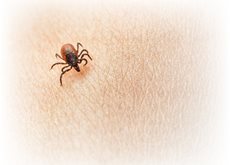Ask a Doc – Lyme Disease with Andrew Seipel, M.D.
 Lyme disease is a bacterial infection transmitted by the blacklegged or deer tick (Ixodes scapularis). Last year, there were 160 confirmed cases of Lyme disease in the entire state, so despite the increase in the population of ticks, the chances of getting Lyme disease are still very low. The infected ticks carry a spirochete – a corkscrew-shaped bacterium called Borrelia burgdorferi and transmit it to humans through a bite. Not all ticks carry the bacteria, and a small bump or redness at the site of a tick bite is common. Urgent treatment for a tick bite is not necessary unless it is confirmed that the tick is a blacklegged tick and the tick has been imbedded in the skin for more than 36 hours. Typically after three days, the symptoms of Lyme disease will begin to develop. Early symptoms of the disease are much like symptoms of the flu.
Lyme disease is a bacterial infection transmitted by the blacklegged or deer tick (Ixodes scapularis). Last year, there were 160 confirmed cases of Lyme disease in the entire state, so despite the increase in the population of ticks, the chances of getting Lyme disease are still very low. The infected ticks carry a spirochete – a corkscrew-shaped bacterium called Borrelia burgdorferi and transmit it to humans through a bite. Not all ticks carry the bacteria, and a small bump or redness at the site of a tick bite is common. Urgent treatment for a tick bite is not necessary unless it is confirmed that the tick is a blacklegged tick and the tick has been imbedded in the skin for more than 36 hours. Typically after three days, the symptoms of Lyme disease will begin to develop. Early symptoms of the disease are much like symptoms of the flu.
- Fever
- Chills
- Sweats
- Fatigue
- Nausea
- Joint pain
- Muscle Aches
As the infection spreads, a patient may develop a rash shaped like a bull’s eye. The Erythema migrans rash has a red, rough center, a clear area, and another larger red area that expands gradually. It also may feel warm to the touch, but it is rarely itchy or painful. Approximately 70 to 80 percent of the people infected with Lyme disease will develop the rash. It is best to contact your primary care physician if you experience the rash or other early symptoms. Most cases of the disease can be treated successfully with antibiotics, but left untreated, the infection can spread to the joints, heart and nervous system.
Months after a tick bite, a patient may start complaining of severe headaches and neck stiffness. The joints may swell – particularly the knees and other large joints. Some experience facial palsy – the loss of muscle tone or droop on one or both sides of the face. Lyme disease can spread to any part of the body and affect any system. It can lead to inflammation of the brain and spinal cord, episodes of dizziness or shortness of breath, and heart palpitations. Antibiotics still can be used to treat Lyme disease in the later stages; however, it may require intravenous antibiotics.
The best defense against Lyme disease is to avoid contact with ticks, especially in the warmer months. In wooded areas, beware of brush, high grass and leaf litter. If you are hiking, stay in the center of the trail. When outdoors, use insect repellents that contain 20 to 30 percent DEET. Products with permethrin are available to treat clothing and outdoor gear such as boots and tents. Do not use permethrin directly on the skin. When returning indoors, bathe or shower as soon as possible to wash off any ticks that may be on the skin. If you do find a tick, remove it right away.
1. Use fine-tipped tweezers to grasp the tick as close to the skin’s surface as possible.
2. Pull upward with steady, even pressure. Do not twist or jerk the tick.
3. After removing the tick, thoroughly clean the bite area and your hands with rubbing alcohol, an iodine scrub, or soap and water.
4. Dispose of a live tick by submersing it in alcohol, placing it in a sealed bag or container, wrapping it tightly in tape, or flushing it down the toilet.
Do not use nail polish, petroleum jelly or heat to try to cause the tick to detach from the skin. The goal is to remove the tick as quickly as possible.
| Posted On : 6/7/2017 2:37:18 PM